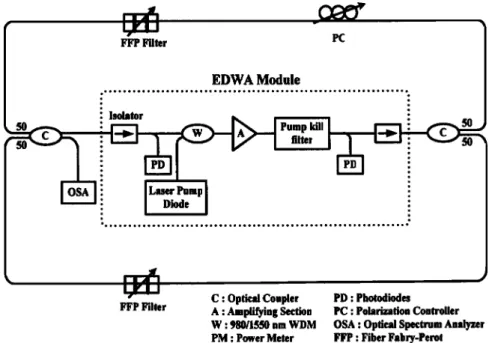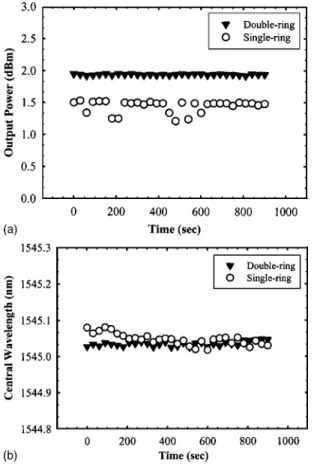Stable and tunable fiber double-ring laser based
on an erbium-doped waveguide amplifier
Hung-Chang Chien
National Chiao-Tung University
Department of Photonics and Institute of Electro-Optical Engineering
1001 Ta-Hsueh Road Hsinchu 300, Taiwan
E-mail: money.eo91g@nctu.edu.tw
Chien-Hung Yeh
Industrial Technology Research Institute N200/CCL
Chutung, Hsinchu 310 Taiwan
Chien-Chung Lee
National Chiao-Tung University
Department of Photonics and Institute of Electro-Optical Engineering
1001 Ta-Hsueh Road Hsinchu 300, Taiwan
Sien Chi
Yuan Ze University
Department of Electrical Engineering Chung-Li 320, Taiwan
Abstract. A stable and tunable fiber double-ring laser based on an
erbium-doped waveguide amplifier (EDWA) is proposed and experimen-tally demonstrated. A widely tunable range from 1527 to 1567 nm, the side-mode suppression ratio (SMSR) of⬎45.6 dB/0.05 nm and the out-put power of⬎1.04 dBm in the operating range from 1535 to 1565 nm can be achieved for this ring laser. By applying the double-ring configu-ration, the ring laser is stabilized. The central wavelength variation of ⬍0.02 nm and the power fluctuation of ⬍0.03 dBm can therefore be retrieved. ©2005 Society of Photo-Optical Instrumentation Engineers.
[DOI: 10.1117/1.1886727]
Subject terms: erbium-doped waveguide amplifier; fiber laser; double ring. Paper 040460 received Jul. 13, 2004; revised manuscript received Sep. 29, 2004; accepted for publication Oct. 21, 2004; published online Mar. 30, 2005.
1 Introduction
Fiber ring lasers based on erbium-doped fibers共EDFs兲 have been studied intensively because of their wide tuning range, high output power, and attractive applications to optical communications, spectroscopy, and fiber sensing. Wave-lengths can be easily tuned by a fiber Fabry-Perot 共FFP兲 filter inside the ring cavity. However, the out wavelength and power of conventional fiber ring lasers are slightly un-stable. Recently, several approaches have been reported to improve the stability of fiber ring lasers, such as using two cascaded FFP filters of wide, different free spectral ranges 共FSRs兲 in the cavity to provide single-longitudinal-mode 共SLM兲 selection and full tenability,1,2 using a compound ring resonator composed of a dual-coupler fiber ring 共DCFR兲 or passive multiple-ring cavity to guarantee SLM laser oscillation.3,4 In this work, a stable and wavelength-tunable fiber ring laser, which employs an erbium-doped waveguide amplifier 共EDWA兲 and double-ring structure, has been proposed and demonstrated. This fiber double-ring laser features both good performance and compact size. Moreover, the characteristics of the output power and wavelength stabilities, tuning range, and side-mode suppression ratio 共SMSR兲 have also been experimentally studied.
2 Experiments
The experimental setup of the stable and tunable fiber double-ring laser based on an EDWA is illustrated in Fig. 1. This apparatus comprises a polarization controller 共PC兲,
two 50:50 optical couplers, two fiber Fabry-Perot filters 共FFP-TP兲, and an EDWA module 共produced by Teem
Pho-tonics兲 with an uncooled laser pump. The EDWA, which is
produced with a two-step ion exchange process in Er/Yb-doped phosphate glass, has the same advantages of the EDFA, such as low noise figure, low polarization depen-dence, and no cross talk between WDM channels. This EDWA module has the feature of a 4.5-dB noise figure over the entire C band, 15-dB small signal gain obtained in the gain medium of only 5 cm, 12-dBm output power when the double-pump scheme is used, and the pump current of 440 mA is applied at ambient temperature. In addition, optical isolators can reduce backward amplified spontaneous emis-sion共ASE兲 and improve noise figure performance, and the pump kill filter is utilized to eliminate 980-nm pump power and keep 1550-nm signal pass. In view of both compact-ness and functionalities, fiber wavelength division multi-plexers 共FWDMs兲, pump kill filter, an uncooled laser pump, and optical isolators are all attached directly into the EDWA module. Therefore, the size of this packaged block is just about 40 cm3and is 1/5 the typical size of EDFA.
Also, two FFP filters are all-fiber devices with free spec-tral range共FSR兲 of 44.5 nm, the finesse of 200, low inser-tion loss of⬍0.5 dB, and low polarization-dependent loss of ⬃0.1 dB. As the external voltages on the piezoelectric transducer 共PZT兲 of two FFP filters are properly adjusted, the stablized wavelength tuning in the double-ring configu-ration can be easily realized. Two FFP filters in the double-ring configuration are nearly tuned to the same wavelength for single frequency output. The stable output wavelength and power of the laser can be easily achieved while the PC in the dual-ring cavity is properly adjusted. In addition, an 0091-3286/2005/$22.00 © 2005 SPIE
Optical Engineering 44(4), 044204 (April 2005)
044204-1
Optical Engineering April 2005/Vol. 44(4)
optical spectrum analyzer共OSA兲 with 0.05-nm resolution is used to measure the output wavelengths and powers of the proposed fiber laser.
3 Results and Discussions
Double-ring configuration, which is regarded as a mode filter, can retrieve the stabilized single wavelength output while the FFP filters and PC within the ring cavities are properly controlled. Therefore, Fig. 2 illustrates the optical spectra of this EDWA-based double-ring laser. When volt-ages from 0 to 12 V are properly applied on the PZTs of two FFP filters, lasing lights from 1527 to 1567 nm can be selected. The insert of Fig. 2 is the ASE spectrum of the EDWA module. Figure 3 shows the output power and SMSR versus the tuning wavelength from 1527 to 1567
nm. As indicated in Fig. 3, the maximum output power of 2.07 dBm is retrieved at around 1555 nm. However, the output powers reduce to ⫺2.51 and ⫺0.43 dBm with the operating wavelength at 1527 and 1567 nm, respectively. The output power is always kept larger than 1.04 dBm over the tuning range of 1535 to 1565 nm. On the other hand, the SMSR can be maintained and is larger than 45.6 dB/ 0.05 nm over the wide tuning range from 1535 to 1565 nm. According to the ASE compression and gain competition effect, the maximum SMSR value can be up to 55.8 dB/0.1 nm around 1537 nm.
The double-ring configuration consisting of the main and subring cavities can serve as a mode-restricting element.4Owing to the vernier effect, the effective FSR in this double-ring cavity is equivalent to the least common multiple number of FSRs in each cavity, and mode suppres-sion can be initially achieved. Next, the main cavity, which is composed of a polarization controller, a Fabry-Perot fil-ter, two 50:50 couplers, and an EDWA, has provided coarse wavelength selection and allows several longitudinal modes to exist in this cavity. The polarization controller is working to compensate the polarization state between vertical and
Fig. 1 Experiment setup of the stable EDWA-based fiber double-ring laser.
Fig. 2 The optical output spectra of the EDWA-based fiber
double-ring laser.
Fig. 3 The output power and SMSR at different wavelengths over
the tuning range from 1527 to 1567 nm. Chien et al.: Stable and tunable fiber double-ring . . .
044204-2
Optical Engineering April 2005/Vol. 44(4)
horizontal modes and stabilize the cavity. Finally, the sub-ring cavity is used to provide fine mode selection by adjust-ing the passband windows of two FFP filters as close as possible, and a polarization controller is not required in the subring cavity. To investigate the behaviors of output power and wavelength stabilities, the stability of the proposed scheme共in Fig. 1兲 is measured and compared with that of the traditional case,5as indicated in Figs. 4共a兲 and 4共b兲. The initial lasing wavelength is set at 1545 nm and the total observing time is over 900 s. In Fig. 4共a兲, the output power fluctuations for the proposed 共double-ring兲 and traditional 共single-ring兲 configuration are 0.03 and 0.32 dBm, respec-tively. Figure 4共b兲 shows that the wavelength variations of the proposed and conventional configurations are 0.02 and 0.06 nm. During 3-h observation, the stable output of the proposed double-ring laser is still maintained. Therefore, when the double-ring structure used, the stabilities of out-put power and wavelength can be improved by as much as 90.63 and 66.67%, respectively.
4 Conclusion
In conclusion, we propose and experimentally demonstrate a stable and tunable double-ring laser based on EDWA. For the double-ring configuration, mode stability is guaranteed, and this fiber double-ring laser exhibits more stable output powers and wavelengths than that of the single ring. A
widely tunable range of 1527 to 1567 nm, an SMSR of ⬎45.6 dB/0.05 nm, and an output power of ⬎1.04 dBm over the operation range of 1535 to 1565 nm are retrieved. Power fluctuation of ⬍0.03 dBm and central wavelength variation of ⬍0.02 nm can also be obtained. The EDWA-based fiber double-ring laser is well suited to WDM net-working applications.
Acknowledgment
This work was supported in part by the National Science Council 共NSC兲 of Taiwan under grants NSC 2752-E009-009-PAE, NSC 2215-E-115-004, and NSC 93-2215-E-115-005.
References
1. K. J. Vahala, P. Namkyoo, J. Dawson, and S. Sanders, ‘‘Tunable, single-frequency, erbium fiber ring lasers,’’ IEEE LEOS ’93 Conf. Proc., pp. 708 –709共1993兲.
2. K. K. Chow, C. Shu, M. W. K. Mak, and H. K. Tsang, ‘‘Widely tunable wavelength converter using a double-ring fiber laser with a semiconductor optical amplifier,’’ IEEE Photonics Technol. Lett. 14, 1445–1447共2002兲.
3. J. Zhang, C. Y. Yue, G. W. Schinn, W. R. L. Clements, and J. W. Y. Lit, ‘‘Stable single-mode compound-ring erbium-doped fiber laser,’’ J. Lightwave Technol. 14共1兲, 104–109 共1996兲.
4. C. C. Lee, Y. K. Chen, and S. K. Liaw, ‘‘Single-longitudinal-mode fiber laser with a passive multiple-ring cavity and its application for video transmission,’’ Opt. Lett. 23共5兲, 358–360 共1998兲.
5. C. H. Yeh, C. C. Lee, and S. Chi, ‘‘A tunable S-band erbium-doped fiber ring laser,’’ IEEE Photonics Technol. Lett. 15共8兲, 1053–1054
共2003兲.
Hung-Chang Chien received his BSEE and MSEE degree from Na-tional Chung-Cheng University, Taiwan, in 1999 and 2001, respec-tively. He is currently a PhD student at the Department of Photonics and Institute of Electro-Optical Engineering, National Chiao Tung University, Taiwan. His research interests are optical fiber commu-nications and optical fiber amplifiers.
Chien-Hung Yeh received the BS and MS degrees from the physics department of Fu Jen Catholic University, Taiwan, in 1998 and 2000, respectively. He received his PhD from the Institute of Electro-Optical Engineering, National Chiao Tung University, Taiwan, in 2004.
Chien-Chung Lee received the MS degree in electro-optical engi-neering from National Central University in 1991 in Taiwan. Also in 1991, he joined the Telecommunication Laboratories, Ministry of Transportation and Communications, in Taiwan (now renamed as Chunghwa Telecomm Laboratories). Since that time he has been working on fiber-in-the-loop technologies, including fiber measure-ment and optical CATV transmission. His current research interests include in-service surveillance technologies for optical networks, and applications of EDFA for WDM transmission and analog video HFC networks. He received his PhD from the Institute of Electro-Optical Engineering, National Chiao Tung University, Taiwan, in 2001.
Sien Chi received his BSEE degree from National Taiwan University and his MSEE degree from National Chiao Tung University, Taiwan, in 1959 and 1961, respectively. He received his PhD in electrophys-ics from the Polytechnic Institute of Brooklyn, New York, in 1971, and he joined the faculty of National Chiao Tung University, where he is currently a professor of electro-optical engineering and vice president of the university. His research interests are optical fiber communications, optical solitons, and optical fiber amplifiers. He is a fellow of the Optical Society of America and the Photonics Society of Chinese-Americans.
Fig. 4 (a) The output power fluctuation and (b) the wavelength
variation of proposed and conventional configurations with the wavelength initially set at 1545 nm.
Chien et al.: Stable and tunable fiber double-ring . . .
044204-3
Optical Engineering April 2005/Vol. 44(4)

